The 9 Wildest Golf Courses in America
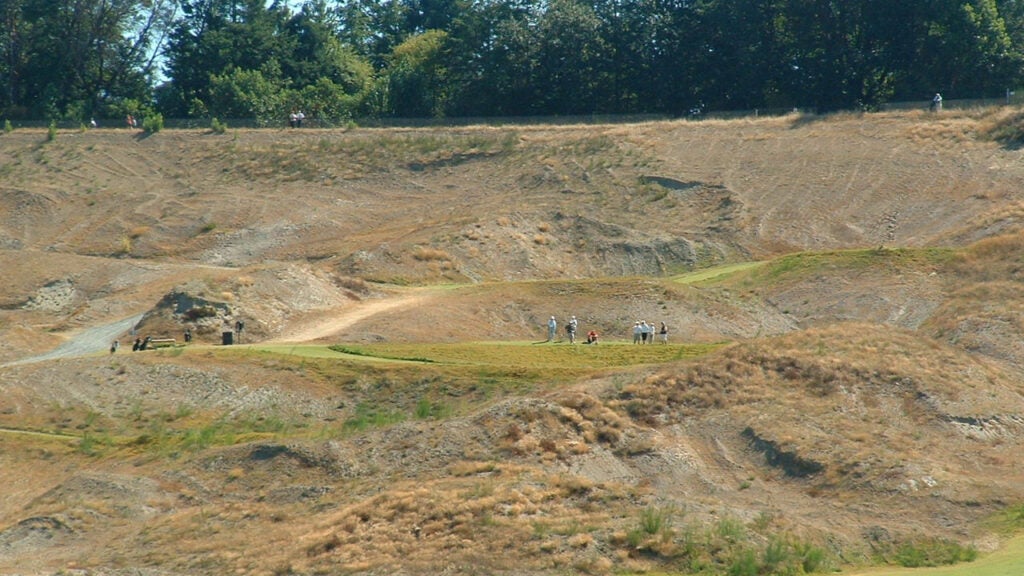
Golf gets a bad rap. The sport has a reputation for being too expensive and too resource-intensive, which are true in some cases. There are private clubs so expensive you need to be a billionaire to join, and courses where the landscape was bulldozed to make way for overwatered and overfertilized fairways.
But not every golf course is that way.
A movement is afoot to make golf more accessible and sustainable. How do I know? I’m an avid golfer. I play twice a week, mostly on public courses that are cheap and built over repurposed farmland. Affordable golf is actually easy to find, but better yet is the sustainability movement that’s creeping into destination courses.
“The golf industry has made tremendous strides in the area of sustainability over the past 20 to 30 years,” says Frank LaVardera, director of environmental programs in golf for Audubon International, which operates America’s first and most comprehensive green-golf-course certification program. “Traditional courses use a significant amount of water and chemicals, but many courses are reducing their amount of managed turf”—the manicured lawns that require so much water and fertilizer—“and creating native areas that require less water, while enhancing wildlife habitat.”
What an Eco-Conscious Golf Course Means
Audubon International’s certification process can take years, and requires evaluation of a course’s impact on wildlife habitat, water quality and conservation, pest management, and energy efficiency. In turn, eco-minded course managers reduce the amount of turf, use recycled gray water to irrigate, emphasize walking over use of gas-powered carts, and create wildlife habitats with natural grasses and trees that attract birds, bees, and even the occasional bear. Since 2001, when the program was introduced, Audubon’s Cooperative Sanctuary Program for Golf has grown to include more than 2,000 certified courses in the U.S. and beyond.
The timing of this sustainability movement couldn’t be better, as America has rediscovered its love of golf. According to the National Golf Foundation (NGF), 3.4 million new people played golf in America last year. Each of the past 10 years saw more than 2 million beginners, with the past four topping 3 million.
Golf’s Changing Demographics
The NGF reports that since the pandemic era, women and people of color have been flocking to the game; the biggest demographic jump has come from traditionally under-represented populations, with the number of Asian, Black and Hispanic golfers rising by 43 percent in the last five years. Of the 26 million people who play golf recreationally, 23 percent are people of color and 26 percent are women.
The demographic makeup of the Professional Golf Association (PGA) is still skewed (80 percent of pro golfers are white), but the game is changing from the ground up as recreational players trend toward being younger and more diverse. The most sought-after clothing brands in the sport, like Malbon and Eastside Golf, bring streetwear aesthetics to the golf industry, while many prolific and successful golfers on social media are women and people of color. If you’re not following Roger Steele on Instagram, you should be.
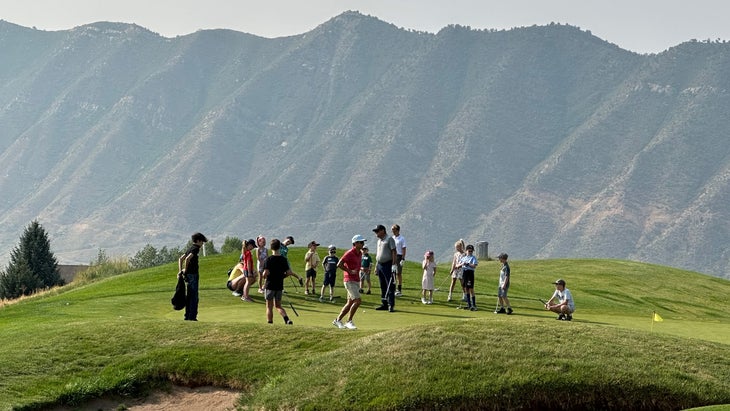
Part of the issue with diversifying the outdoors is access. There were 480 ski resorts in operation last year, with most of them located in remote, mountainous regions. Compare that to the 16,000+ golf courses scattered all over the country. I live in a southeastern mountain town that is not known for its golf, but I can play on any of 10 courses situated within half an hour of my home. There are three courses within three miles of downtown, and I play on two of them for under $20 a round. A program called Youth On Course enables members aged 18 and under to play any of its 2,133 enrolled courses across the U.S. for just $5 a round.
My 15-year-old son is a YOC member, and able to play half a dozen courses within 10 miles of our home. He and I can walk nine holes of golf for $20 combined, $35 if we want to play 18.
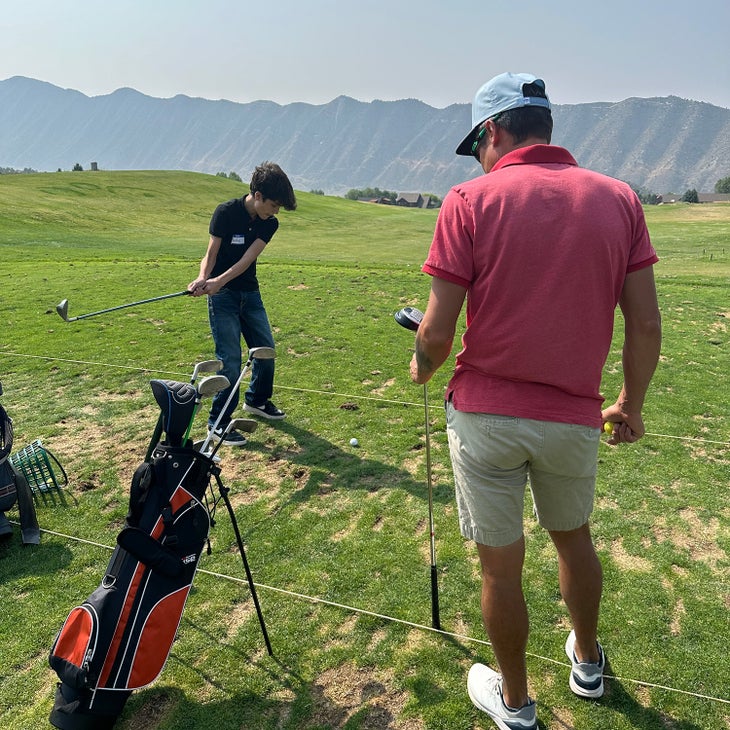
Why I Love Golf
As for the argument that golf shouldn’t be considered an outdoor sport because of its environmental impact, most things we do leave footprints. I’ve been a dedicated skier since age 12, and I don’t love the fact that the ski industry has gotten cartoonishly expensive and is resource-intensive, especially in water use. But I do love skiing. I have the same relationship with golf. It’s not perfect, but I love it.
This surprises people because I make a living writing about adventure sports, and I have the scars and expensive-gear habit to prove it. People assume golf and surfing or mountain biking are a world apart, but look closely in my garage and you’ll see a set of golf clubs tucked between my mountain bike and longboard.
When I play, I always walk, carry my bag, and try not to focus too much on my score. It’s a slow, meditative walk in the woods. I like the challenge of golf as well. I recently picked the sport up again after a 20-year-hiatus, and I’m consumed with the pursuit of getting better, but I also know that I’ll never master golf. No matter how good I get at hitting a little white ball in the air, there will always be room for improvement.
Golf is cerebral and thought-provoking in a way that the other fast-paced sports I love are not. The game is 99.99 percent mental, allowing me to see how my thoughts impact my actions. Golf is a chance to clear your head and be outside.
Fortunately, there are certain destinations where golf and adventure go hand in hand. Some of the most sustainable golf courses in America are located in places that could be on any adventure-traveler’s radar, so you can play 18 holes one afternoon and go mountain biking or surfing the next morning.
Here are nine of the wildest, most sustainable golf courses in the world, each paired with a local adventure to round out the perfect weekend.
If you buy through our links, we may earn an affiliate commission. This supports our mission to get more people active and outside. Learn more.
1. Bear Trace, Harrison, Tennessee
Fee: Starting at $41 for 18 holes

Even if you’re not a golfer, you know the name of Jack Nicklaus, one of the game’s most famous professionals. Not only was Nicklaus a legendary golfer, he was also a designer, creating courses all over the country, including this 18-hole masterpiece sits in the 1200-acre Harrison Bay State Park, 20 miles outside of Chattanooga. In the last two decades, managers have addressed every aspect of the course to minimize its impact, converting the greens from bentgrass to a less-thirsty Bermudagrass, removing 50 acres of turf to cede that area to natural grasses, and eliminating irrigation beyond the greens. The place has also purchased all-electric maintenance equipment, and installed mallard nesting tubes, wood duck boxes, and feeders for bluebirds and wild turkey.
As a result, as of 2008, Bear Trace is a certified Audubon Cooperative Sanctuary, and restored the wildlife habitat to the point where the course was home to a pair of nesting bald eagles for a decade.
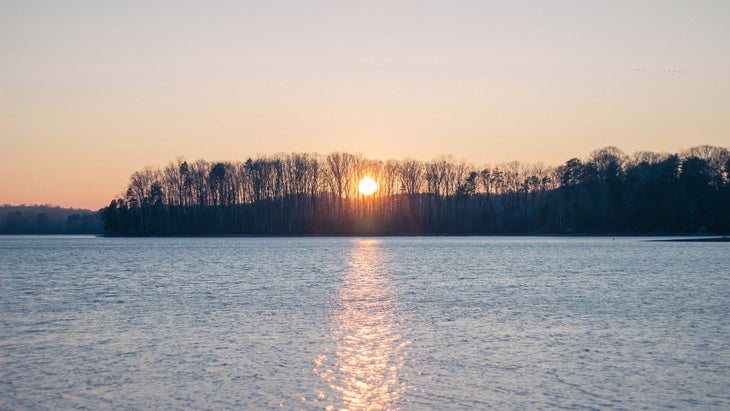
Nearby Adventure: Paddling on Chickamauga Lake in Harrison Bay State Park makes for a fun afternoon (paddle boards are $8 an hour through the park). If you’re looking for something more adventurous, Ocoee River Rafting, 45 miles west of the state park, offers trips (from $50 per person) on class III-IV whitewater full of play spots and wave trains that formed the 1996 Olympic whitewater course.
2. Big Cedar Lodge, Ridgedale, Missouri
Fees: Starting at $60 for 18 holes
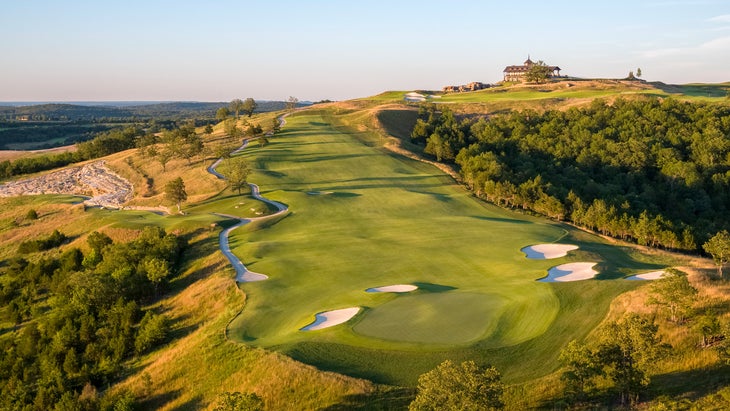
OK, Big Cedar Lodge is a behemoth. The brainchild of Johnny Morris, the founder of Bass Pro Shops, the 4,600-acre retreat features five distinct public golf courses, all set amid a dramatic Ozark Mountains backdrop, with routing that regularly nears ancient limestone cliffs. In recent years, Big Cedar Lodge has become one of the country’s top golf destinations, regarded as the best public golf in the Midwest.
Big Cedar Lodge was the first golf resort in the world to receive Audubon International’s highest certification, the Signature Sanctuary status, given for all five of its courses. Water conservation and improving wildlife habitat are priorities, with more than 75 percent organic fertilizer used, while chemical runoff and water use are addressed through a water-recycling program with reclamation ponds, as well as moisture meters embedded in the ground to help minimize watering in general.
One of Johnny Morris’ founding principles is the notion of connecting people and the outdoors. On several holes his courses put the golfer between towering limestone cliffs, and, extra cool, those who play Big Cedar Lodge’s Buffalo Ridge course can spy herds of bison that roam and feed on the natural-grass prairies surrounding the fairways.
Nearby Adventure: You could spend your entire weekend playing different courses at Big Cedar Lodge, but bring your mountain bike, too. The resort is on the edge of Table Rock State Park, which has 11 miles of cross-country trails in a stacked-loop system that hugs the shoreline of Table Rock Lake. Or you could hit the gravity-minded Howler Bike Park, which has 10 trails and a pump track and skills area. The place has something for everyone, from the kid who’s just learning how to brake, to the adult who thinks he’s a kid sending gaps (day passes start at $45).
Book Airbnbs in Ridgedale, Missouri
3. Streamsong Golf Resort, Bowling Green, Florida
Fees: Starting at $249 for 18 holes
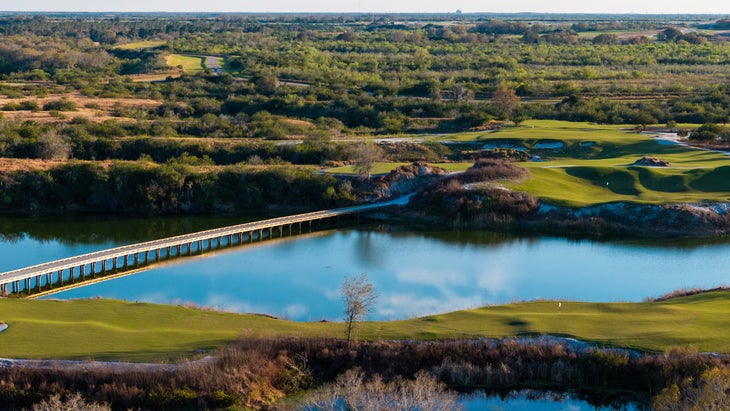
This massive golf retreat 60 miles east of Tampa wins my vote for best use of scarred land. Streamsong built its courses on 16,000 acres of land that was previously used for a phosphate strip mine. After the mining ended, sand dunes took over, and course designers used all of that bumpy elevation to create a whimsical playground where fairways wind through grassy mounds and small ponds.
Course designers used compost in the soil before grassing to reduce the need for fertilization, and limited the acreage of maintained turf, opting instead for natural grasses and dunes beyond the fairways. The resort has a water-treatment facility that captures rainwater, and reuses it for irrigation. Streamsong features three 18-hole courses, and a short course, called The Chain, that has no set tee boxes or suggested pars. This short course is a “choose your own adventure” sort of experience.
Nearby Adventure: You can keep the reclaimed land theme rolling by driving 25 miles west to Alafia River State Park, 7,714 acres of surprisingly hilly terrain on a former phosphate mine, with more than 20 miles of mountain biking and hiking trails through a forest and alongside lakes and the banks of the Alafia River. Streamsong wasn’t impacted much by Hurricane Milton when it hit October 9, both because the courses were designed to manage water and the place had few trees for high winds to damage. But much of this area of Florida was devastated by the storm, so check with surrounding businesses and parks before exploring the area.
Book Airbnbsin Bowling Green, Florida
4. Chambers Bay, University Place, Washington
Fees: Starting at $85 for 18 holes

This 18-hole course is links-style, meaning that like Scotland’s St. Andrews, believed to be the oldest course in the world, it has little to no manipulation of the land, resulting in rugged terrain, with many dunes covered in tall grasses. Similarly set on a craggy shoreline of Washington, it might also be the pinnacle of sustainable design. Chambers Bay was built on reclaimed mine land, turning a former gravel pit into a championship course that now enhances the landscape. Designers shaped the course with native plants and wildflowers like douglas iris, and sodded with drought-resistant fescue grass species.

The fairways are irrigated with recycled gray water and fertilized with treated bio-waste from the county’s wastewater plant. Chambers Bay doesn’t have golf carts; it’s a walking-only facility. (Some courses in the U.S. require golfers to use carts on weekends to maintain a quick pace of play.) Maybe the best part is that Chambers Bay is a municipal course, with affordable fees. It’s also located within a county park with trails adjacent to the links and coast, so you don’t have to play golf to enjoy the scenery.
Nearby Adventure: Chambers Creek Regional Park, which is home to the golf course, is a 930-acre preserve with two miles of shoreline and more than five miles of paved trails with views of Puget Sound. You should also drive 50 miles east to Mount Rainier National Park, where you can hike the 5.5-mile loop on Skyline Trail, bagging copious views of the eponymous 14,411-foot active volcano in all its glaciated glory.
Book Airbnbs in University Place, Washington
5. Black Desert Resort, Ivins, Utah
Fees: Starting at $300 for 18 holes

A 19-hole course that opened in May 2023, Black Desert Resort was built from the ground up with the surrounding environment in mind. The entire property is only 600 acres, with just 75 acres of turf, all irrigated with non-potable gray water, and the fairways are made from a drought-tolerant bentgrass species that needs less maintenance and fertilizer than many other common turf grasses. Almost 70 percent of the grounds are dedicated as protected open space, and sustainability was a factor throughout the property’s design, from having a low-voltage power infrastructure for the resort to using an irrigation system in a grid, where each section can be adjusted individually.
The coolest aspect of the course is that it’s become a haven for endangered fish species. The property managers partnered with the Utah Division of Wildlife Resources to relocate 400 Virgin River Chub, a kind of rare minnow, to the lakes on the golf course, so they can live and breed in a stable environment. The course itself is gorgeous, running through fields of black lava rocks with views of the surrounding red cliffs.
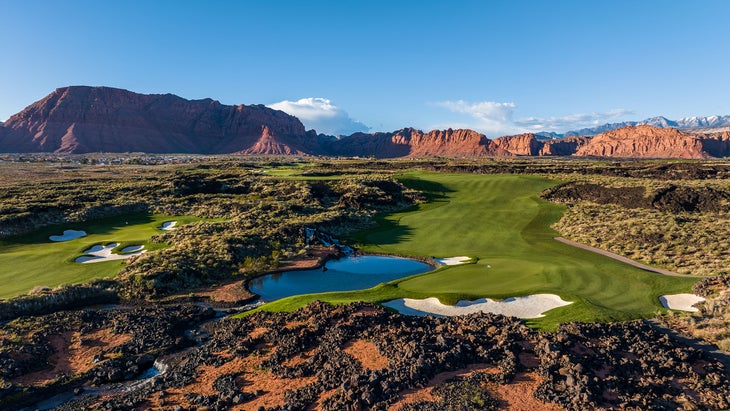
Nearby Adventure: Long-term plans for Black Desert include building several miles of hiking trails. Moreover, the resort sits nine miles north of St. George, just an hour (48 miles) west of Zion National Park. If it’s your first time to Zion, snag a permit ($3 plus a $6 registration fee) and hike Angel’s Landing, a 5.5-mile out-and-back that involves a bit of scrambling and ridgeline traversing and might just lead to one of the most iconic photo sites in our national-park system.
To dig deeper into the park, consider trekking through The Narrows, a slot canyon where the walls of Zion Canyon rise 1,000 feet up while pinching to 30 feet wide at certain points. You’ll be hiking through the river, so be prepared to get wet. The shortest route is a 9.5-mile out and back from the Temple of Sinawava, a red-walled natural amphitheater, to Big Spring, which is as far as you can go without a permit, but hits some of the skinniest portions of the gorge. Just don’t attempt it when there’s rain in the forecast, as flash floods are common and fatalities have occurred. Save it for a stellar day.
6. The Mountain Course at Spruce Peak, Stowe, Vermont
Fees: Starting at $165 for 18, and you need to stay at The Lodge at Spruce Peak to play (rooms start at $249).

Surrounded by 2,000 acres of preserved land, the Mountain Course at Spruce Peak rambles along the flank of the mountain it is named for, with views of the adjacent Mount Mansfield, Vermont’s tallest peak, to boot. Spruce Peak, which sits at the base of Stowe Mountain Resort, was designed with the environment in mind, input from Audubon International, and a focus on preserving local black-bear populations by routing around their preferred habitat of beech trees. Designers also created buffers around streams and ponds to protect water quality, and planted a mix of native flowers and grasses, like milkweed and false sunflower, around tee boxes.
Peregrine Lake serves as a water feature for golfers to admire and avoid, but also a reservoir capturing rainwater that is used to feed snowmaking operations at Stowe Mountain Resort. Course management hosts an annual field trip to teach a local fifth-grade class about the elements of water quality.

The course fits into the greater ecosystem of the Spruce Peak community, a resort and residential property at the base of Stowe Mountain Resort that was built around eco-sensitive principles like a property-wide composting program and a renewable energy program that provides more than 50 percent of its power.
Nearby Adventure: You’re close to Stowe, a town renowned for its ski culture (and beer). Sadly, ski season and golf season don’t overlap. But don’t fret; during the warmer months, there is plenty of hiking, fly fishing, and climbing nearby. Do it on your own or if you want a guide, Spruce Peak Resort offers hiking and fly fishing adventures. If you’re into climbing, Sunrise Mountain Guides runs trips on the granite walls around the Stowe area, from top-roping routes suitable for beginners to multi-pitch cliffs that will please experienced trad climbers (from $250 per person).
Check flights to Stowe, Vermont
7. Bandon Dunes, Bandon, Oregon
Fees: From $50 for the par 3 courses

Bandon Dunes has become one of the most coveted golf destinations in America, with seven public courses spread throughout the 2,525-acre coastal resort. All seven courses have earned Audubon International Sanctuary status, too, as the designers have kept Oregon’s coastal beauty and environmental harmony in mind throughout the process, from construction to management.
The course looks wild, thanks largely to the use of native plants and grasses, including the threatened silver phacelia, outside of the fairways, while for the turf on those mowed areas Bandon Dunes uses fescue, a type of grass that requires less fertilizer than others. And when fertilizer is applied, it’s organic and used sparingly. Roughly 85 percent of the resort’s energy is supplied by renewable resources, with more solar panels still to be installed throughout the property. The maintenance department has moved to electric-powered equipment.
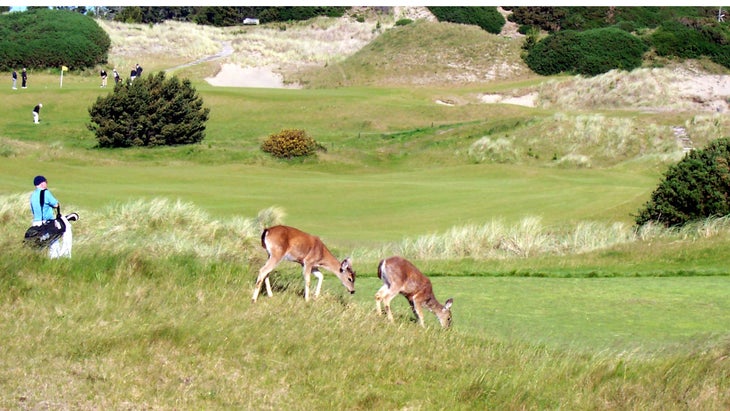
Most of the resort’s landscape holds native plants that require no irrigation, but with six courses, roughly 600 acres that need to be watered. The resort’s own wastewater-management system supplies non-potable gray water for the job, recycling roughly 50,000 gallons of water daily.
One of the courses, Bandon Preserve, puts net proceeds directly to local conservation projects in Oregon’s southern coast through a grant program, which has helped restore salmon fisheries and funded mountain bike trails. Bandon Dunes is working towards the lofty goal of becoming a completely carbon neutral resort.
Nearby Adventure: Bandon Dunes sits on Oregon’s southern coast, which is a multi-sport adventurer’s dream, with miles of singletrack and wild beaches punctuated by dramatic sea stacks. Go for a trail run at Bullards Beach State Park, where several miles of trail wind through a pine forest and access five miles of hard-packed beach.
The surfing is good too, with beach breaks found throughout this part of the coast. Head north for 25 miles to Coos Bay, where the bluffs of Yoakam Head hang over the breaks, which have something for all levels of surfers. Beginners should head to Bastendorff Beach for a wide, sandy-bottom break with a cool backdrop of rocky headlands. The water temperature is cold year round, but winter brings the most consistent waves, so in that case pack a thick wetsuit.
Book Airbnbs in Bandon, Oregon
8. The Broadmoor, Colorado Springs, Colorado
Fees: Starting at $110 for 18 holes
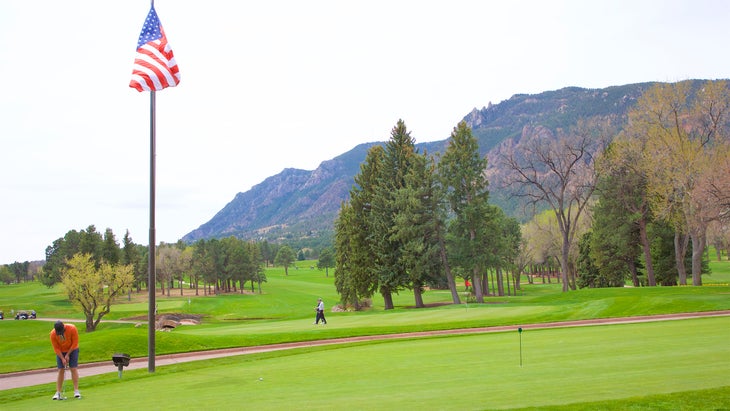
The Broadmoor, a resort five miles south of Colorado Springs, is home to two of the most respected golf courses in the U.S., designed by legends Donald Ross and Robert Trent Jones and hosting marquee tournaments like multiple U.S. Amateurs, U.S. Women’s Opens, and U.S. Senior Opens. At 6,250 feet in elevation, the course was the highest in America when it first opened in 1918, and several holes feature views of Pikes Peak.
The place has become significantly more eco-friendly with age. Managers have replaced more than 50 acres of turf with native grasses and wildflowers, and use gray water to irrigate the fairways and greens. Mulching mowers return grass clippings back to the soil, and the property uses no pesticides Over the years the resort has added bird-nesting boxes and habitats for bees and butterflies. All of the carts are electric, and otherwise the place promotes walking and its caddy program. Resort chefs harvest honey from the property’s own hives, and source meat from the Wagyu beef raised on the ranch. Even the resort’s cooking grease is recycled into biodiesel.
The Broadmoor participates in one of the most heartwarming recycling programs I’ve ever heard of: all of their spent tennis balls are donated to local senior-citizen facilities to be used on the ends of walkers and canes.
Nearby Adventure: Colorado Springs offers so much to do. The 14,115-foot Pikes Peak, with trailheads six miles from town, has to be the most accessible fourteener in the U.S.; you can drive your car or take a train to the summit, but I say earn it by hiking the Barr Trail ($20-$37 parking fee, depending on day of week), a 13-mile one way trek that gains more than 7,000 feet on its way to the top. Don’t worry, you can take the shuttle down from the summit ($30). Or go explore the iconic red sandstone fins that rise from the center of Garden of the Gods Park. Front Range Climbing operates half and full day trips for all abilities (starting at $221).
Book Airbnbs in Colorado Springs, Colorado
9. Rising Sun Golf Course, Emigrant, Montana
Fee: Greens fees are included in the cost of your stay (one week minimum, and you must contact the resort for pricing).

It’s hard to beat Rising Sun’s location. The 18-hole course sits on the 17,000-acre Mountain Sky Ranch, within the aptly named Paradise Valley and with near-constant views of the surrounding Absaroka and Gallatin Mountains. This is the biggest splurge on this list, and for most, a once-in-a-lifetime situation at best, but the rest of us can dream, right?
Rising Sun is not an easy course to play, thanks to its remote location and the fact that tee times go only to guests of the ranch, but you couldn’t ask for a more beautiful setting, and the Rising Sun was the first course in Montana to be designated an Audubon International Cooperative Sanctuary. The course was built on a hayfield with an emphasis on maintaining as much natural habitat as possible, converting dry pastures to prairie grass, and maintaining native plant buffers along bodies of water.
Course managers also installed bird-nest boxes to encourage multi-species nesting, and have put in bat houses. They regularly consult with Montana Fish, Wildlife and Parks on issues concerning elk and Yellowstone Cutthroat Trout. Aided by a dry, cold environment, course managers use no pesticides for the turf and greens, and they’ve limited water usage by keeping the irrigated acreage to only 52 acres, almost a third of the average 18 hole course in America. Maintenance crews regularly monitor the quality of water in the course ponds as well as Big Creek.
Nearby Adventure: Mountain Sky Ranch is an adventure-minded “dude ranch” with a host of activities located on property. The resort also offers guided horseback tours in Yellowstone National Park, with an entrance just 30 miles south. But I say to pair a round of golf here with some fly fishing. If you’re new to the sport, Mountain Sky has a trout pond where pros can teach you the nuances of casting, but if you can hit the ground running, head to nearby Big Creek, which is loaded with cutthroat and rainbow trout. Or sign up for a guided float and cast trip of the iconic Yellowstone River, which offers opportunities for long, wide open casts that just might net a cutthroat or brown. (From $595)
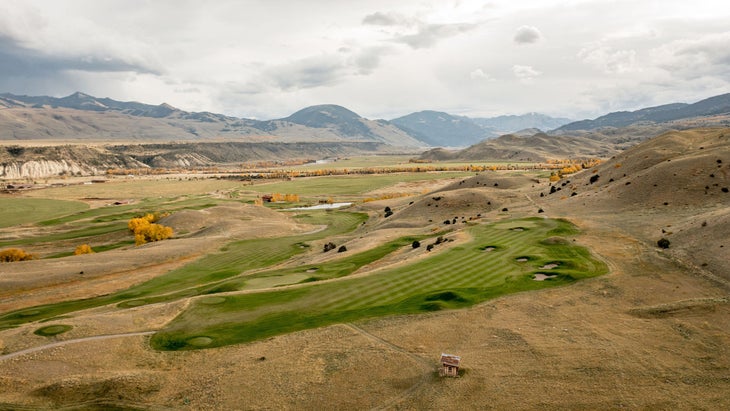
Nearby Adventure: Mountain Sky Ranch is an adventure-minded “dude ranch” with a host of activities located on property. The resort also offers guided horseback tours in Yellowstone National Park, with an entrance just 30 miles south. But I say to pair a round of golf here with some fly fishing. If you’re new to the sport, Mountain Sky has a trout pond where pros can teach you the nuances of casting, but if you can hit the ground running, head to nearby Big Creek, which is loaded with cutthroat and rainbow trout. Or sign up for a guided float and cast trip of the iconic Yellowstone River, which offers opportunities for long, wide open casts that just might net a cutthroat or brown (from $595).
Check flights to Bozeman, Montana
Graham Averill is Outside magazine’s national parks columnist and an avid golfer who is dying to play every course on this list. Follow his golf shenanigans on Instagram at @the_amateur_golf. Graham recently wrote “This Is What It’s Like to Live in Asheville After Hurricane Helene” and answered some questions about it while standing in line at FEMA offices. He has also recently written “9 Most Underrated National Parks for Incredible Fall Foliage,” “8 Surf Towns Where You Can Learn the Sport and the Culture,” and “The 9 Most Fun Adventure Lodges in North America.”
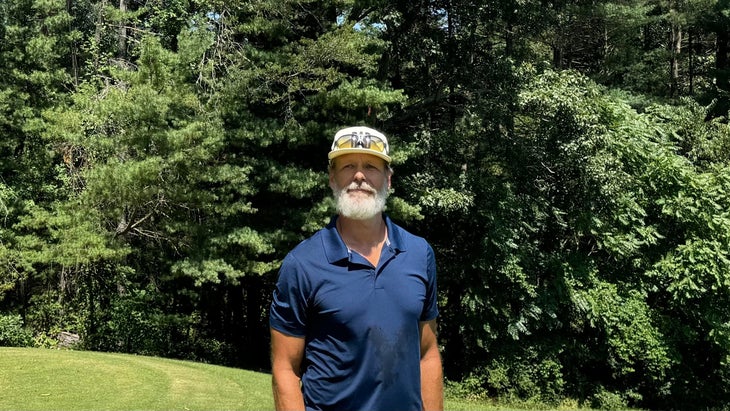
Related
I Tried Bryson DeChambeau’s Actual 7-iron And It Blew My…
The story of how Bryson DeChambeau came to play the Avoda Golf one-length irons is a fascinating one, but arguably not as fascinating as the actual specificati
Australian PGA Championship: Elvis Smylie holds off Cameron Smith to…
Elvis Smylie held off former Open champion Cameron Smith down the back nine to win the Australian PGA Championship in Brisbane on Sunday.The 22-year-old Queensl











